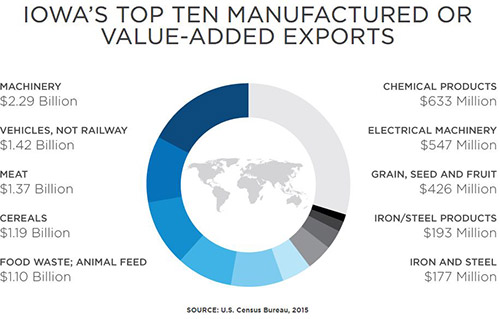Don’t let our #1 rankings in corn, eggs, and pork production fool you — Iowa is a manufacturing state. Employing more than 200,000 skilled workers, advanced manufacturing is Iowa’s single largest industry.
In fact, 85 percent of the state’s total exports are manufactured goods and nearly 16 percent of U.S. agriculture equipment employees work in Iowa. With all this industry, Iowa has the highest concentration of machinery manufacturing employees in the country, according to Bureau of Labor Statistics data.
As a state we are aggressively working on several initiatives to meet the future needs of advanced manufacturers. One of these initiatives includes offering manufacturers data-driven models of their supply chains to plan new locations and optimize their shipping and receiving models. We’re engaging in partnerships to prepare our major highway corridors for autonomous freight. We use a higher percentage of wind for our electricity — over 36 percent — than any state and we make it easier than any other state for businesses to purchase renewable electricity directly. And while already owning the #1 spot in the nation in public high school graduation rates, Iowa is also setting ambitious goals for post-secondary education and STEM-skills training.

In 2015, the Iowa Economic Development Authority and the Iowa Department of Transportation (Iowa DOT) partnered with a private consulting group to create a model of the major supply chains in the state. The project integrated public- and private-sector freight data in a computer model to represent current and forecasted demand, transportation and inventory capacity, and quantitative performance data.
The state is using this model to make strategic investments in freight infrastructure, such as a new intermodal hub under development near Cedar Rapids. This location is the only place in the country that can serve Chicago, Milwaukee, Minneapolis, St. Louis, and Omaha by freight carrier in a one-day round-trip as permitted by federal regulation.
The state is also offering this model as a service to private companies interested in reducing their own supply chain costs. The model can provide an analysis of demand and capacity across a company’s supply chain, and provide recommendations for places to make strategic investments.
This strategy is part of an overall effort by the state of Iowa to prioritize infrastructure investment in places that will improve safety and efficiency for both our residents and our business community. Another example is how the state embraces autonomous freight fleets.No state has gone further to advance autonomous fleets.
The U.S. Department of Transportation recently named the Iowa City/Cedar Rapids I-380 corridor one of 10 automated vehicle proving grounds in the nation. Unlike other proving grounds, the corridor features a variety in climate, road users, and roadway landscapes. It also includes the nation’s largest and most expansive virtual simulated testing ground at the National Advanced Driving Simulator on the campus of the University of Iowa.
This announcement came after the Iowa DOT partnered with HERE — a digital mapping company owned by Audi, BMW, and Daimler — to map the I-380 corridor. The Iowa DOT is now offering this data for free to private companies that would like to test advanced vehicle technologies in the area. It’s the latest progressive move for Iowa, which is also leading the way in renewable energy usage.

If access to renewable power is a deciding factor in your site evaluation, the data shows that Iowa is the best place to look for a new location. A 2017 joint report from the Retail Industry Leaders Association and the Information Technology Industry Council said Iowa is the easiest place in the country for manufacturers to source renewable energy for their operations.
The state received this ranking because Iowa’s utilities generate more than 36 percent of the state’s electricity from wind — the highest percentage of any state. Iowa’s grid is also the #1 most stable of any state according to U.S. News & World Report, and the most recent U.S. Energy Information Administration data found our industrial electricity rates to be more than 19 percent below the national average.
To push our leadership further, Iowa’s utilities have pledged to invest $4.6 billion in additional wind capacity. MidAmerican Energy, a Berkshire Hathaway subsidiary and the state’s largest utility, has power purchase agreements in place with Google and Facebook to provide their Iowa data centers with 100 percent renewable energy. There are very few utilities in the country that have the ability or experience to create and fulfill renewable energy power purchase agreements on this scale. Last year, Iowa’s second largest energy utility, Alliant Energy, also announced a $1 billion investment to add 500 megawatts of wind capacity. These investments and others show Iowa’s commitment to renewable energy and is a major differentiator for a manufacturing state that is also setting ambitious goals for its workforce.
Iowa’s goal is to have 70 percent of the workforce with training beyond high school by 2025. Iowa’s top-tier education system is focused on creating workers for the future of manufacturing. Iowa already has the highest public high school graduation rate in the country, and leaders of the state’s government are making post-secondary education a priority. The stated goal of this initiative, called Future Ready Iowa, is for 70 percent of Iowans in the workforce to have education or training beyond high school by 2025.

Additionally, due to the state’s low cost of living, this skilled manufacturing labor is available in Iowa for an affordable rate. Overall the state of Iowa offers the second lowest cost of doing business in the country. To reduce upfront costs to expanding or relocating employers, the state has also developed a robust certified sites program.
Seventeen certified, development-ready sites are available throughout the state.
Are you ready to consider an expansion in Iowa? Iowa’s certified site program is overseen by the nationally recognized site selection firm McCallum Sweeney Consulting. Currently, 17 sites are deemed to be relatively risk-free for development, and most have access to rail. All of Iowa’s certified sites can be viewed at iowaeconomicdevelopment.com/certifiedsites.


